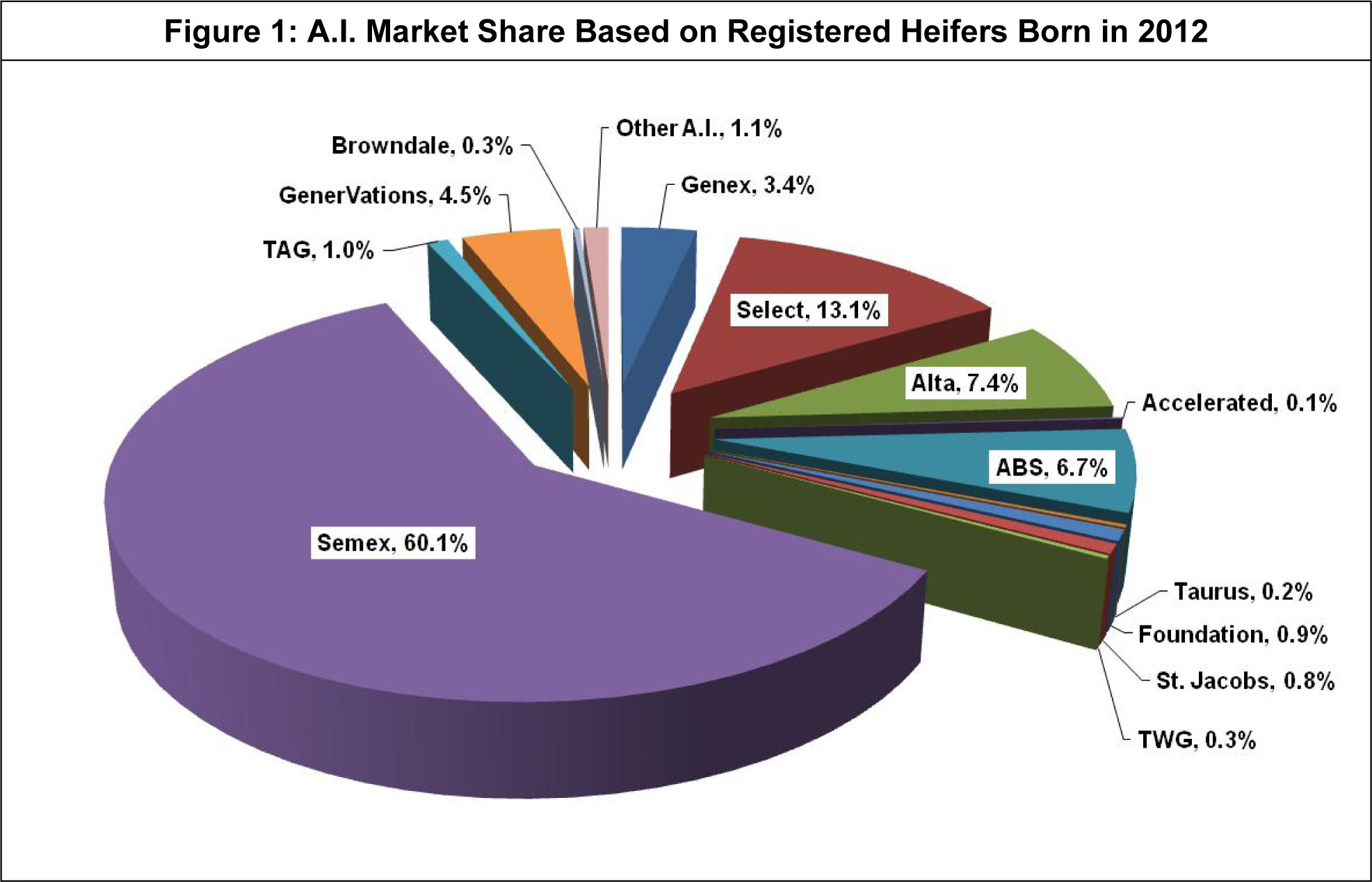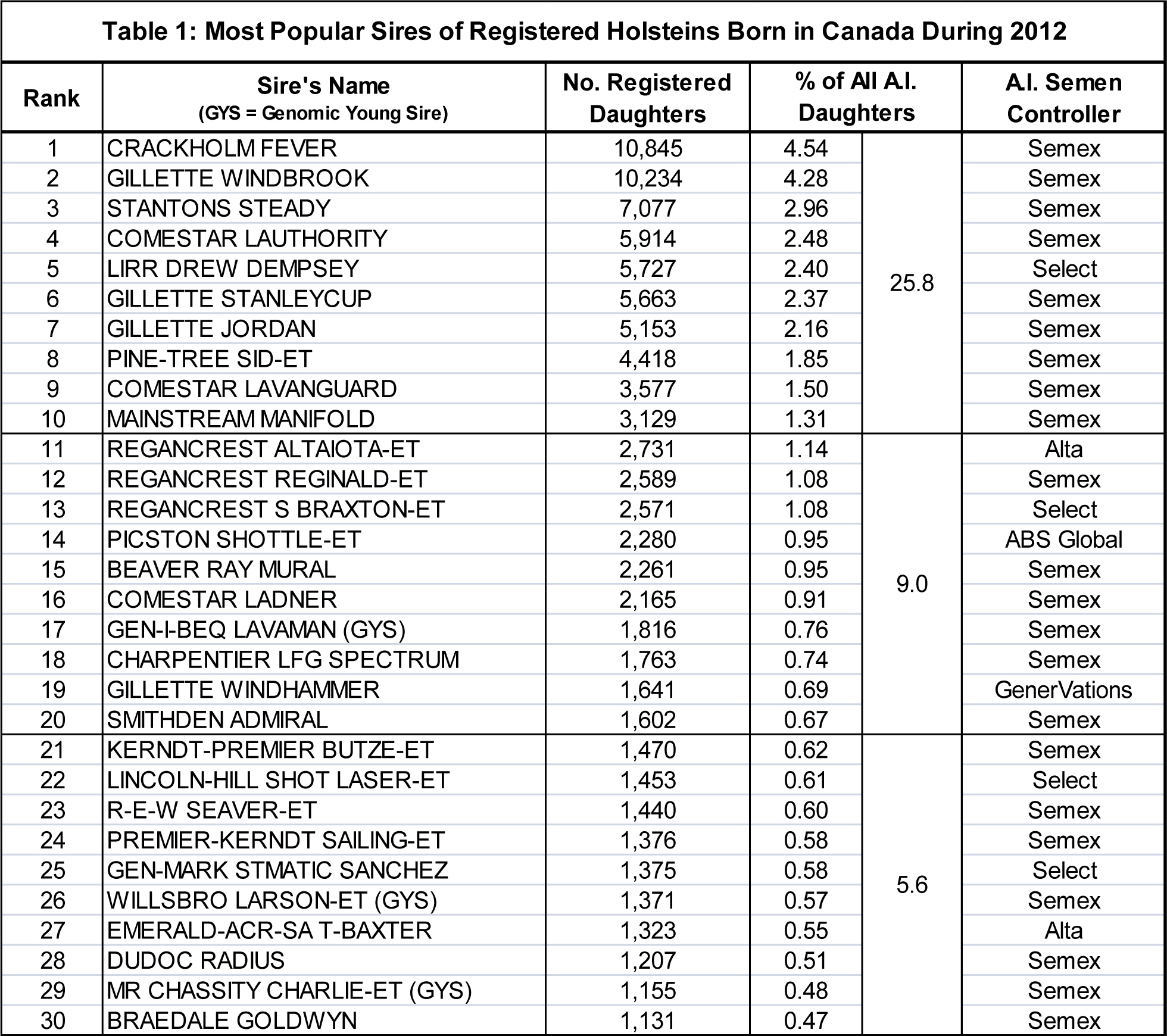One of the most important factors contributing to the rate of genetic progress in a breed is the selection of sires by producers for breeding cows and heifers in their herd. The resulting pregnancies and heifer calves born become the main source of replacement heifers, which leads to the genetic gain achieved in each herd and therefore within the breed population. Given the bank of data at CDN related to all elements of genetic improvement, a recent analysis was established for providing annual statistics regarding the market share held by the various A.I. organizations marketing their sires in Canada as well as the list of the most popular sires of heifers born in Canada and registered in the breed association herdbook.
A.I. Market Share
A total of 280,915 dairy heifers were born in Canada in 2012 and registered in the respective breed association herdbook, of which 94.6% were Holstein. Of these, 89.9% were daughters of A.I. sires and therefore the national usage of herd sires was 10.1%. Herd sire usage varied widely by province with the lowest rates amongst registered heifers in Newfoundland (1.2%), Québec (4.1%) and Nova Scotia (6.7%) and the highest rates in Saskatchewan (38.1%), Alberta (28.6%) and Manitoba (17.9%).

On a national level, the 2012 market share occupied by the various A.I. companies marketing semen in Canada is represented in Figure 1. As the largest nationally based A.I. organization with decades of history in Canada, the partners within the Semex Alliance occupied 60.1% of the market share in 2012. By region, Semex Alliance surpassed 74% in Quebec, attained 55% in Ontario and Atlantic Canada and occupied 44% in Western Canada. Three other companies had a national market share exceeding 5%, namely Select Sires (13.1%), Alta Genetics (7.4%) and ABS Global (6.7%). Regionally, Select Sires occupied 15-17% of the market share in Western Canada, Ontario and Atlantic Canada in 2012 with nearly 8% in Quebec. For Alta Genetics and ABS Global, Western Canada was their highest region taking 17% and 11% of the market share based on herdbook registered daughters. Full details of A.I. market share statistics by province are available on the Canadian Dairy Network (CDN) web site at http://www.cdn.ca/articles.php.
Popular Sires of Heifers Born in 2012
From time to time, usually on a yearly basis, CDN also conducts an analysis of the most popular sires of registered heifers born in Canada. Table 1 provides the 30 Holstein sires with the highest number of daughters born in 2012 that were registered by Holstein Canada.

Two progeny proven sires, namely Crackholm Fever and Gillette Windbrook, produced more than 10,000 registered daughters born in 2012, jointly representing nearly 5% of the yearly total. Of major interest, however, is the relatively wide variety of sires amongst the list in Table 1. In fact, the 10 most popular sires of registered daughters born in 2012 represent just over 25% of all such heifers in Canada. While these were all progeny proven sires, the era of genomics has also led to the inclusion of three genomic young bulls amongst the 30 most popular sires of heifers born in 2012, as indicated by the “GYS” label in the table. In total, over 40% of the registered Holstein heifers born in 2012 were sired by the list of 30 most popular sires presented in Table 1. Also, over 5,900 different sires had at least one registered daughter born in 2012, and one-third of all sires represented had at least 10 registered daughters. The oldest sire with registered daughters born in 2012 is Rosafe Citation R*RDC (HOCANM267150), who was born in 1958.
Summary
The rate of genetic improvement in a breed is highly dependent upon the sires used by producers in their herd to generate the next generation of replacement heifers. Canada has various A.I. organizations marketing semen from their bulls and these companies are members of CDN. Each organization competes for market share, which can vary from province to province. An examination of the most popular sires for registered heifers born in 2012 indicates that the top 10 Holstein sires represent over 25% of all such heifers in that breed and genomic young bulls are also now entering the list of the 30 most common sires for 2012.
Source: Canadian Dairy Network









